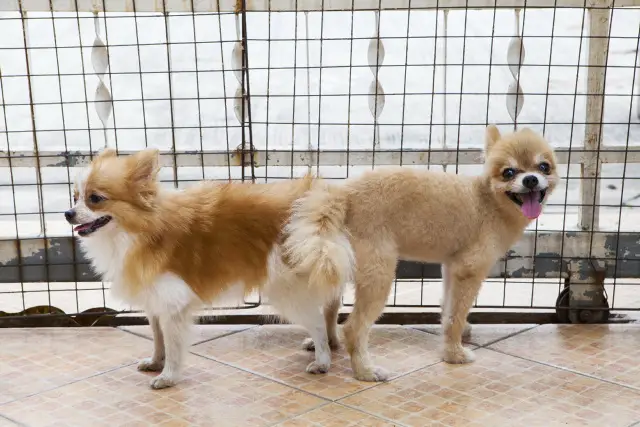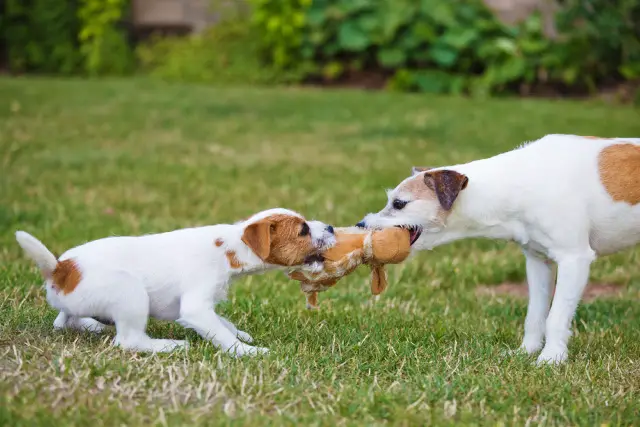When your female dog had puppies, you decided not to break up the family. You continued to care for her and the father dog as well as the puppies. Now that the puppies are mature adults, you’re considering breeding them. Will a male dog mate with its offspring?
Male dogs don’t recognize their puppies as their own and thus will have no qualms about mating with a female dog that’s technically their daughter. However, the offspring are likelier to be born with congenital defects. Future female fertility can be affected as well.
In this article, we’ll discuss whether male dogs are even willing to mate with their offspring and expound further on the risks of doing so. Make sure you keep reading!

Will a Male Dog Mate With His Offspring?
In a recent article on the blog, we discussed whether male dogs know or recognize their offspring.
The answer, in case you missed that article (and it’s definitely worth going back and giving it a read), is no.
Male dogs are usually separated from the mother for several weeks before she gives birth as well as several weeks after. This prevents the puppies from learning his scent the same way they do the scent of their mother.
To add further to matters, male dogs also lack a paternal instinct. They don’t see their puppies as different from any other animal in the pack.
When you add those two factors together, you’ll realize very quickly that a male dog would readily mate with his daughter. The male doesn’t see the dog as his daughter anyway, just another female dog.
The female dog might not mind it either. She might have never seen her father before, or if she did, it was for very limited periods when she was young.
Is It Okay for a Father Dog to Breed With Its Daughter? Here Are the Risks
Just because two related dogs will willingly mate does not mean it’s okay. If a father and daughter breed, it carries with it a lot more risks than rewards. Let’s talk about the dangers now.
Behavioral Issues
When breeding dogs, the goal is to produce the ideal canine in terms of look and temperament.
The latter certainly wouldn’t be achievable if a father dog mated with his daughter. Behavioral issues tend to run more rampant with inbred dogs, so the puppy would have a smattering of unwanted traits.
For instance, the offspring would have a much higher chance of snapping at other dogs or animals or even biting them. The rough play would be something this dog is more predilected to as well.
These kinds of behaviors can be sort of cute in puppyhood when a dog can’t cause much harm. Once the dog matures though, if they continue to be rough, what was once cute behavior can quickly turn aggressive.
If a dog seriously attacks another canine in the house or a member of your family, it doesn’t matter if the dog was inbred or not. You usually have to take that dog out of the house or it will attack again.
Lower Intelligence
Another desirable trait of a dog is high intelligence. This is usually achieved by breeders selecting only pedigreed dogs to mate.
A brainy puppy will train easily, picking up on new tasks and commands quickly. They’ll listen well, retain information, and learn a variety of things, from the basic commands such as sit and stay, to agility courses.
By inbreeding a dog, its intelligence will naturally be a lot lower than its breed standard will suggest. This will make training difficult. Training goes beyond learning to sit and stay, by the way.
If you try to teach an inbred dog to stop having accidents in the house or to stop ripping up the furniture, you’re going to have your work cut out for you.
Health Issues
We’ll talk a little more about genes in a moment, but it’s no secret that a father and daughter share the same gene pool.
So let’s say that a dog breed is likely to develop a dangerous health condition. If the father has the genes for that condition and so does the daughter and the two dogs mate, the offspring is almost assuredly going to end up with that condition as well.
Even outside of that, an inbred puppy is likelier to have congenital defects, which are genetic abnormalities. Recessive genes, while usually not the dominant gene, can become more so when two related dogs mate.
The puppies could be born with skeletal deformations, cancer, facial and body abnormalities, eye disorders, and other health issues.
Higher Risk of Mortality
Luck is not on the side of an inbred puppy. With so many health issues right out of the womb that will only become more pronounced in the years to come, most inbred puppies have a very short lifespan compared to the breed standard.
Some dog owners might decide to euthanize the animal because the puppy is struggling so much so young and their quality of life is not likely to improve with time.
Reduced Female Fertility
Are you interested in continuing to breed the puppies that come out of this latest round of mating? Then the father and daughter should not breed.
The lack of genetic variation between the two dogs means that any female puppies that are healthy and survive will be born with lower rates of fertility.
If the dog did get pregnant, she’s at an elevated risk of having an absorbed litter as an inbred dog. An absorbed litter is when the fetuses die in the womb and are absorbed there via enzymes.
Even if an inbred female dog got pregnant and didn’t have an absorbed litter, the risk of dystocia or abnormal labor is higher in inbred dogs.
She may have a much more difficult time giving birth than most dogs in her breed, and a C-section may be required.
Very Limited Gene Pool
Genes are designed to evolve over time. It’s how animals learn to adapt to changes and survive. It’s how they evolve.
When you limit the gene pool by inbreeding dogs, that genetic evolution does not get to take place.
This puts the future of the lineage at risk, a lineage that you might have worked very hard to cultivate by carefully selecting mates for your dogs to this point.
The Ethical Concerns of Inbreeding Dogs
Outside of the undeniable risks above, there are also ethical concerns to keep in mind if you’re contemplating inbreeding a father and daughter dog.
Just as two humans shouldn’t inbreed because it’s wrong (and often illegal), it’s just as wrong for two animals to do it. Even though no laws prohibit it and even though the dogs don’t have any moral objections to it, you should.
You have higher intelligence between humans and dogs, so use that higher intelligence to do the right thing.
If you’re breeding dogs for adoption, no one is going to want to adopt an inbred dog. Most are born with so many health issues right off the bat that the red flags would pop up left and right for a potential adopter.
Even if the puppy was born okay, its congenital conditions could occur later in life. It’s not right to adopt that dog to someone and leave them in the dark about that.
You also won’t ensure a healthy and long-lasting lineage by inbreeding dogs. Instead, all you’re doing is setting yourself up for a lot of expensive vet bills and a lot of heartaches.
You’ll have to watch the mother dog struggle and the puppies struggle as well. Some won’t make it, and others will have such a hard life that you’ll decide there’s no need to continue it.
You’re much better off breeding the father and daughter separately than with each other.
Can You Keep a Father Dog With Its Offspring?
Going back to our point from earlier, it’s recommended in many cases that you separate the male and female dog in the late stages of her pregnancy for at least six weeks but possibly longer.
You already know that male dogs aren’t paternal, but some can be downright aggressive towards the mother and her puppies. These dogs are likely jealous that they’re no longer getting the lion’s share of attention.
Thus, until the puppies are about six weeks old, it’s best to keep the father in a separate part of the house.
After that, you can begin introducing the two. Just don’t expect a wholesome, tear-jerking family moment or you’ll be disappointed.
Male dogs might act indifferently towards their offspring. Some males are affectionate, but this is simply a general trait and doesn’t mean the dog is showing love. Remember, the male doesn’t recognize the puppies as its children.

Conclusion
Male dogs will mate with their offspring, but this is an extremely poor idea from a number of perspectives.
The offspring, if they survive at all, are likely to be born with bad genes, congenital health issues, lower intelligence, and aggressive behavior.
Take the time to find proper mates for your male dog and his offspring, but don’t let them breed with each other.
Related Reading:
Do Male Dogs Recognize or Know Their Puppies?
9 Cavapoo Health Problems To Look Out For
Are Cavapoos Aggressive Dogs? Answered!
What To Do When A Cavapoo Has Zoomies
When Do Cavapoo Dogs Calm Down? (Plus 5 Calming Tips)
